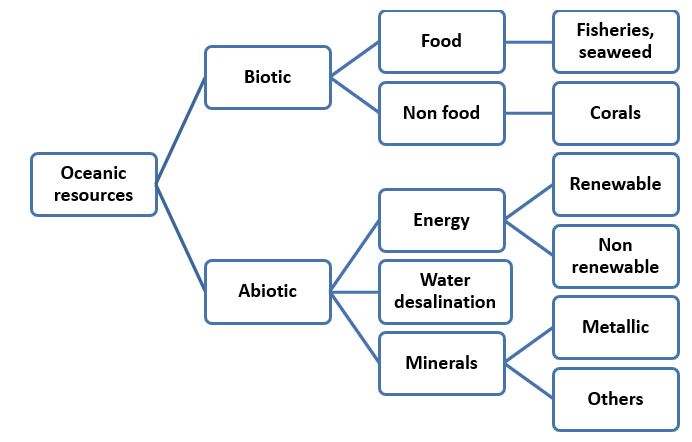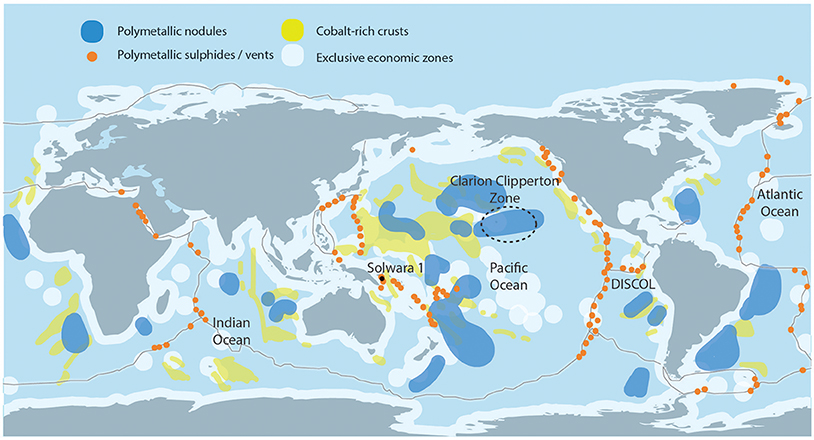Deep Ocean Mission
2021 JUN 29
Mains >
Science and Technology > National institutions & initiatives > Blue water policy
IN NEWS:
- The Cabinet Committee on Economic Affairs chaired by the Prime Minister has approved the proposal of Ministry of Earth Sciences (MoES) on "Deep Ocean Mission".
DEEP OCEAN MISSION:
- It is the Government of India mission to explore deep ocean for resources and develop deep sea technologies for sustainable use of ocean resources.
- The estimated cost of the Mission will be Rs. 4077 crores for a period of 5 years to be implemented in a phase-wise manner.
- Ministry of Earth Sciences (MoES) will be the nodal Ministry implementing this multi-institutional ambitious mission.
- Deep Ocean Mission with be a mission mode project to support the Blue Economy initiatives of the government.
- The Deep Ocean Mission consists of six major components:
- Development of Technologies for Deep Sea Mining and Manned Submersible:
- A manned submersible will be developed to carry three people to a depth of 6000 metres with a suite of scientific sensors and tools.
- An Integrated Mining System will be also developed for mining Polymetallic Nodules from 6000 m depth in the central Indian Ocean.
- Development of Ocean Climate Change Advisory Services:
- A suite of observations and models will be developed to understand and provide future projections of important climate variables.
- Technological innovations for exploration and conservation of deep-sea biodiversity:
- Bio-prospecting of deep-sea flora and fauna including microbes and studies on sustainable utilization of deep sea bio-resources will be the main focus.
- Deep Ocean Survey and Exploration:
- Explore and identify potential sites of multi-metal Hydrothermal Sulphides mineralization along the Indian Ocean mid-oceanic ridges.
- Energy and freshwater from the Ocean:
- Studies and detailed engineering design for offshore Ocean Thermal Energy Conversion (OTEC) powered desalination plant are envisaged.
- Advanced Marine Station for Ocean Biology:
- Development of human capacity and enterprise in ocean biology and engineering, to translate research into industrial application and product development.
- The mission will bring together experts from the Indian Space Research Organisation, Defence Development and Research Organisation, Department of Atomic Energy, Council of Scientific and Industrial Research, Department of Biotechnology and the Indian Navy.
DEEP SEA RESOURCES:

- Traditionally, resources such as fish, oil and gas have been taken from the sea for many decades.
- More recently, oceans are being targeted as a source of renewable energy. Eg: Ocean thermal energy conversion to produce electricity for desalination.
- The most significant targets for new deep-sea mining efforts are polymetallic sulphides, manganese nodules and cobalt-rich ferromanganese crusts.
- On a longer run, there will be interest in the potential extraction rare earth elements (REEs) in deep-sea muds and gas hydrates in the ocean floor. Gas hydrates are a crystalline solid formed of water and gas. It looks and acts much like ice, but it contains huge amounts of methane.

SIGNIFICANCE:
- Push for blue economy:
- India has a 7517 km long coastline, which is home to around 30 per cent of the population. India’s Exclusive Economic Zone (EEZ) spreads over 2.2 million square kilometers.
- The mission will give a boost to the efforts of exploring the EEZ as well as the continental shelf and thus help in leveraging the idea of blue economy for the country’s overall economic growth.
- Enhance energy security:
- The mission’s focus on off-shore energy development can diversify and strengthen India’s energy basket. It will also facilitate India’s move towards sustainable energy resources.
- Enhance mineral security:
- It has been estimated that 380 million metric tonnes of polymetallic nodules are available at the bottom of the seas in the Central Indian Ocean. Utilizing these deposits can help supplement the depleting land-based mineral reserves of India for the next few decades.
- Sustainable development:
- Sustainable resource extraction from land-based sources is proving to be a major challenge. Also, SDG 14 explicitly calls for sustainable use of marine resources. In this regard, the deep-sea mission seeks to develop sustainable solutions.
- Capacity development:
- The mission has special emphasis on capacity development in areas of marine biology, blue trade and blue manufacturing. This will help create strong research, innovation and entrepreneurship ecosystem in the country.
- Impetus for Indian industries:
- Design, development and fabrication of specialised equipment, ships and setting up of required infrastructure are expected to spur the growth of the Indian industry, especially the MSME and Start-ups.
- Front runner in deep sea mining:
- At present, the technologies required for deep-sea exploration and mining are not commercially available. By developing extraction technology and capability, India can become a pioneer in mineral extraction in the future.
- Develop indigenous capabilities:
- Only a very few countries have acquired the technological capabilities deep sea mining and manned submersible. The mission seeks to develop indigenous capabilities in these areas, which can help India acquire similar benefits it enjoys with its indigenous space industry.
- Strategic advantage:
- Global: Deep sea mineral exploration and use of deep-sea resources is one area where there are no clear international legislations or guidelines. Through the mission, India aims is to be prepared when such rules are formalized.
- Regional: The move is strategically significant as it will enhance India’s presence in the Indian Ocean where other players like China and Korea are active.
CONCERNS:
- Absence of international legislations:
- Sustainable extraction and equitable sharing of resources obtained from global commons require effective international legislation, which is currently lacking. Hence, commercial utilization of deep sea resources is currently questionable.
- The global commons include those parts of the Earth's surface beyond national jurisdictions — notably the outer space, Antarctic, open ocean and the living resources found there.
- Economic viability of mining:
- The latest estimate from the International Seabed Authority says it will be commercially viable only if about three million tonnes are mined per year. But to attain such levels, more studies are being carried out and technology needs to be scaled up rapidly.
- Disturbance of seafloor:
- Geologically, the impacts of deep-sea mining are yet to be conclusively analysed. Some forms of deep-sea mining will stir up fine sediments on the seafloor, creating plumes of suspended particles. It is unclear how far these particles may disperse, how long it would take for them to resettle, and to what extent they may affect ecosystems and species.
- Effect on ecology:
- On benthic ecosystem: The scraping of the ocean floor can alter or destroy deep-sea habitats, leading to the loss of species and fragmentation or loss of ecosystem structure and function. Many species living in the deep sea are endemic and physical disturbances can possibly wipe out an entire species.
- On pelagic ecosystem: Sediment plumes can reduce the oceanic productivity, which will in turn affect the oceanic food web.
- Pollution:
- Species such as whales, tuna and sharks could be affected by noise, vibrations and light pollution caused by mining equipment and surface vessels, as well as potential leaks and spills of fuel and toxic products.
OTHER BLUE ECONOMY INITIATIVES:
- Decade of Ocean Science for Sustainable Development:
- Considering importance of the oceans on sustainability, the United Nations (UN) has declared the decade 2021-2030 as the Decade of Ocean Science for Sustainable Development.
- Agreement with ISA:
- India had signed a 15-year contract with the International Seabed Authority (ISA) in 2016 for exploration of Poly-Metallic Sulphides (PMS) in the Indian Ocean. Based on this, India has ear-marked nearly 1.5 lakh square kilometres of area in the central Indian Ocean for exploration.
- Component of ‘New India by 2030’:
- The Government of India's Vision of New India by 2030 enunciated in February 2019 highlighted the Blue Economy as one of the ten core dimensions of growth.
- O-SMART:
- Ocean Services, Technology, Observations, Resources Modelling and Science (O-SMAT) is an umbrella scheme under the Ministry of Earth Sciences which encompasses a total of 16 sub-projects addressing ocean development activities.
- The important deliverables envisaged under the scheme include:
- Strengthening of Ocean Observations and Modelling
- Strengthening of Ocean Services for Fishermen
- Setting up Marine Coastal Observatories for monitoring marine pollution
- Setting up Ocean Thermal Energy Conversion Plant (OTEC) in Kavaratti
- Acquisition of 2 Coastal Research Vessels for Coastal research
- Continuation of Ocean Survey and Exploration of Minerals and Living Resources
- Technology Development for Deep Ocean Mining- Deep Mining System and Manned Submersibles
- Setting up Six Desalination Plants in Lakshadweep.
- Sagarmala project:
- The Sagarmala project seeks to leverage the country's coastline and inland waterways to drive industrial development.
- Its key objectives include:
- Port Modernization & New Port Development
- Enhancing the connectivity of the ports to the hinterland
- Developing port-linked industrial clusters and Coastal Economic Zones
- Coastal Community Development
- Coastal Shipping & Inland Waterways Transport development
- ORV Sagar Nidhi:
- Sagar Nidhi is an ocean research vehicle operated by the National Institute of Ocean Technology (NIOT).
- The ship is the first of its kind in the country and has been used for the launch and retrieval of remotely operable vehicle (ROV) and the deep-sea nodule mining system, as well as for tsunami studies.
CONCLUSION:
The unsustainable terrestrial resource exploitation has led to a shortage of land resources. This has forced us to venture into uncharted territories deep within the ocean to meet our future resource demands. The exploration studies of minerals will pave way for the commercial exploitation in the near future, as and when commercial exploitation code is evolved by the International Seabed Authority, an UN organization. Though a pioneer in this field, India should take care to see that the resources are extracted and used in a sustainable manner with minimum impacts on the deep-sea environment.
PRACTICE QUESTION:
Q. Discuss the significance of India’s Deep Ocean Mission?
